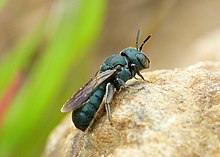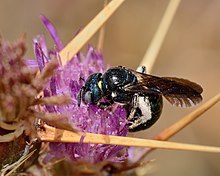Ceratina
| Ceratina | |
|---|---|

| |
| Ceratina sp. | |
| Scientific classification | |
| Kingdom: | Animalia |
| Phylum: | Arthropoda |
| Class: | Insecta |
| Order: | Hymenoptera |
| Family: | Apidae |
| Tribe: | Ceratinini |
| Genus: | Ceratina Latreille, 1802 |
| Species | |
|
>200 species | |
The cosmopolitan bee genus Ceratina, often referred to as small carpenter bees,[1] is the sole lineage of the tribe Ceratinini, and closely related to the more familiar carpenter bees. They make nests in dead wood, stems, or pith, and while many are solitary, a number are subsocial, with mothers caring for their larvae, and in a few cases where multiple females are found in a single nest, daughters or sisters may form very small, weakly eusocial colonies (where one bee forages and the other remains in the nest and lays eggs). One species is unique for having both social and asocial populations, , which exhibits all of the pre-adaptations for successful group living. This species is socially polymorphic with both solitary and social nests collected in sympatry. Social colonies in that species consist of two foundresses, one contributing both foraging and reproductive effort and the second which remains at the nest as a passive guard. Cooperative nesting provides no overt reproductive benefits over solitary nesting in this population, although brood survival tends to be greater in social colonies. Maternal longevity, subsociality and bivoltine nesting phenology in this species favour colony formation, while dispersal habits and offspring longevity may inhibit more frequent social nesting in this and other ceratinines.[2]
Ceratina are commonly dark, shining, even metallic bees, with fairly sparse body hairs and a weak scopa on the hind tibia. Most species have some yellow markings, most often restricted to the face, but often elsewhere on the body. They are very commonly mistaken for "sweat bees" (family Halictidae), due to their small size, metallic coloration, and some similarity in wing venation; they can be easily separated from halictids by the mouthparts (with a long glossa) and the hindwings (with a tiny jugal lobe).[3]
In , a Mediterranean species, males may guard the opening to the nest of a female they hope to mate with, and are often not the father of the brood within the nest; this is the first bee species in which male nest-guarding has been classified as a form of biparental care,[4] but males guarding nests and mating with females has been documented in other species (e.g., Macrotera portalis[5]).
A few species of Ceratina are exceptional among bees in that they are parthenogenetic, reproducing without males.[6]



Species[]
- † (Cockerell 1906)
- H. S. Smith, 1907
- Ceratina acantha Provancher, 1895
- Cockerell, 1919
- Friese, 1896
- Friese, 1917
- Friese, 1917
- Vachal, 1903
- Kokujev, 1905
- Cockerell, 1937
- Cockerell, 1937
- Cockerell, 1931
- Baker, 2002
- Cockerell, 1937
- Strand, 1912
- Cockerell, 1932
- Daly, 1973
- (Daly, 1983)
- Ceratina arizonensis Cockerell, 1898
- Smith, 1854
- Schrottky, 1902
- Strand, 1910
- Strand, 1910
- Cockerell, 1937
- Friese, 1917
- H. S. Smith, 1907
- Ducke, 1911
- H. S. Smith, 1907
- (Perkins, 1912)
- Cresson, 1878
- Benoist, 1955
- H. S. Smith, 1907
- Eardley & Daly, 2007
- Eardley & Daly, 2007
- Ceratina beata Cameron, 1897
- Baker, 1907
- Cockerell, 1916
- Bingham, 1908
- Smith, 1879
- Cockerell, 1918
- (Moure, 1941)
- Cockerell, 1937
- Ceratina binghami Cockerell, 1908
- Cockerell, 1920
- Handlirsch, 1889
- Yasumatsu, 1955
- Baker, 2002
- Eardley & Daly, 2007
- Friese, 1905
- Michener, 1954
- Cockerell, 1919
- Cockerell, 1919
- Ceratina calcarata Robertson, 1900
- (Fabricius, 1794)
- Cockerell, 1919
- Smith, 1879
- Baker, 2002
- Schrottky, 1907
- Spinola, 1841
- Germar, 1839
- Chevrier, 1872
- (Wu, 1963)
- (Fabricius, 1804)
- Terzo, 1998
- Cockerell, 1912
- Gerstäcker, 1869
- Cockerell, 1937
- Cockerell, 1935
- Cockerell, 1919
- Friese, 1917
- Ceratina cobaltina Cresson, 1878
- Ceratina cockerelli H. S. Smith, 1907
- Smith, 1879
- Cockerell, 1919
- Friese, 1910
- Smith, 1879
- Meunier, 1890
- Baker, 2002
- Nurse, 1904
- Schrottky, 1907
- Cameron, 1908
- Friese, 1925
- Cockerell, 1903
- (Rossi, 1792)
- Smith, 1879
- Strand, 1910
- Ceratina cyanea (Kirby, 1802)
- Schrottky, 1902
- Cresson, 1865
- Cockerell, 1918
- Mavromoustakis, 1954
- Ceratina dallatorreana Friese, 1896
- Terzo, 1998
- Strand, 1912
- Friese, 1910
- Baker, 2002
- Terzo, 1998
- Friese, 1914
- Gerstäcker, 1869
- Smith, 1879
- Cockerell, 1932
- Friese, 1910
- H. S. Smith, 1907
- Friese, 1910
- Ceratina dupla Say, 1837
- Cockerell, 1911
- Friese, 1917
- Nurse, 1904
- Cockerell, 1937
- Cockerell, 1937
- Wu, 2000
- Cockerell, 1924
- Vachal, 1903
- Yasumatsu & Hirashima, 1969
- Cockerell, 1937
- Smith, 1862
- Fox, 1896
- Morawitz, 1875
- Smith, 1879
- Cockerell, 1916
- Smith, 1858
- Gussakovsky, 1933
- Strand, 1912
- Cockerell, 1916
- Friese, 1925
- Ducke, 1908
- Friese, 1917
- Michener, 1954
- Eardley & Daly, 2007
- Schrottky, 1909
- Schrottky, 1907
- Gerstäcker, 1869
- Genaro, 1998
- Strand, 1912
- Kocourek, 1998
- Terzo & Rasmont, 2004
- Eardley & Daly, 2007
- Baker, 2002
- Ceratina hieroglyphica Smith, 1854
- Friese, 1910
- Cockerell, 1916
- Daly, 1973
- Cresson, 1878
- Friese, 1910
- Bingham, 1898
- (Hirashima, 1969)
- Friese, 1905
- Nurse, 1904
- Alfken, 1926
- Cockerell, 1931
- Yasumatsu, 1936
- van der Vecht, 1952
- Cockerell, 1911
- S. Lee, 2005
- Strand, 1913
- Michener, 1954
- Friese, 1905
- Morawitz, 1895
- Wu, 1963
- Strand, 1912
- Cockerell, 1934
- Friese, 1905
- Friese, 1910
- Cockerell, 1937
- van der Vecht, 1952
- Cockerell, 1932
- Vachal, 1903
- van der Vecht, 1952
- Strand, 1912
- Gerstäcker, 1869
- Smith, 1879
- Nurse, 1902
- Smith, 1854
- Cockerell, 1934
- Strand, 1914
- Friese, 1905
- Shiokawa & Hirashima, 1982
- Friese, 1911
- Smith, 1854
- Friese, 1900
- Daly, 1983
- (Daly, 1988)
- Friese, 1896
- Cockerell, 1912
- Baker, 1907
- Yasumatsu, 1939
- Lepeletier, 1841
- Yasumatsu & Hirashima, 1969
- (Moure, 1941)
- Cockerell, 1924
- Cockerell, 1920
- Cresson, 1878
- Daly, 1973
- Friese, 1909
- Friese, 1905
- Friese, 1896
- Cameron, 1897
- Vachal, 1903
- Holmberg, 1886
- Sickmann, 1894
- Friese, 1899
- Strand, 1910
- Friese, 1910
- Nurse, 1902
- Eardley & Daly, 2007
- Ceratina nanula Cockerell, 1897
- Friese, 1905
- Strand, 1912
- Cockerell, 1937
- Cockerell, 1897
- Daly, 1983
- Cockerell, 1901
- Friese, 1909
- Handlirsch, 1889
- Friese, 1905
- Ashmead, 1900
- Michener, 1954
- Friese, 1917
- Gerstäcker, 1869
- Friese, 1896
- Cockerell, 1916
- Cockerell, 1937
- Cockerell, 1937
- Strand, 1912
- Cockerell, 1919
- Matsumura & Uchida, 1926
- Friese, 1905
- Schrottky, 1907
- H. S. Smith, 1907
- Cockerell, 1937
- Yasumatsu, 1939
- van der Vecht, 1952
- Schrottky, 1907
- Cockerell, 1931
- Smith, 1854
- (Daly, 1988)
- Cockerell, 1935
- Friese, 1905
- Strand, 1912
- Smith, 1879
- Cockerell, 1937
- Friese, 1905
- Ceratina picta Smith, 1854
- Smith, 1861
- Schrottky, 1911
- Smith, 1862
- Friese, 1902
- Cockerell, 1937
- Wu, 1963
- Cameron, 1897
- Smith, 1879
- Shiokawa, 2002
- Cockerell, 1916
- van der Vecht, 1952
- Friese, 1910
- Spinola, 1841
- Wu, 2000
- Cockerell, 1912
- Terzo, 1998
- Schwarz & Michener, 1954
- Cockerell, 1912
- Cockerell, 1937
- Schrottky, 1909
- Cockerell, 1910
- Cockerell, 1937
- (Daly, 1988)
- Vachal, 1909
- Smith, 1879
- Cockerell, 1937
- (Hirashima, 1969)
- Smith, 1879
- Smith, 1879
- Cockerell, 1932
- Holmberg, 1884
- Cockerell, 1937
- Terzo, 1998
- Cockerell, 1910
- Yasumatsu, 1936
- Daly, 1983
- Strand, 1913
- Kocourek, 1998
- Terzo, 1998
- Schrottky, 1907
- Smith, 1858
- Strand, 1912
- Ceratina sequoiae Michener, 1936
- Friese, 1910
- Daly, 1973
- Smith, 1854
- Ceratina smaragdula (Fabricius, 1787)
- Cockerell, 1920
- Cockerell, 1937
- Cockerell, 1932
- Moure, 1941
- Ceratina strenua Smith, 1879
- Eardley & Daly, 2007
- Smith, 1854
- Cockerell, 1937
- Cockerell, 1912
- Strand, 1912
- Shiokawa & Hirashima, 1982
- Ceratina tanganyicensis Strand, 1911
- (Moure, 1941)
- Morawitz, 1872
- Strand, 1919
- Cresson, 1864
- Cockerell, 1937
- Terzo & Rasmont, 1997
- Daly, 1973
- Morawitz, 1895
- Daly, 1973
- Cockerell, 1903
- Cockerell, 1914
- Michener, 1954
- Friese, 1917
- Crawford, 1910
- Moure, 1941
- Friese, 1905
- (Moure, 1941)
- Friese, 1911
- Smith, 1879
- (Baker, 1997)
- Terzo & Rasmont, 1997
- Schrottky, 1920
- Friese, 1910
- Cockerell, 1931
- Cockerell, 1934
- Guérin-Méneville, 1844
- Friese, 1910
- (Shiokawa & Sakagami, 1969)
- Terzo, 1998
- Eardley & Daly, 2007
- (Moure, 1941)
- Cockerell, 1912
- Hirashima, 1971
- Cockerell, 1931
- Terzo, 1998
- Friese, 1921
- Cockerell, 1934
- Terzo & Rasmont, 1997
References[]
| Wikimedia Commons has media related to Ceratina. |
- ^ Small Carpenter Bee – Ceratina sp. Red Planet Inc.
- ^ Rehan, S., Richards, M., & Schwarz, M. (2010). Social polymorphism in the Australian small carpenter bee, Ceratina (Neoceratina) australensis. Archived 2016-03-07 at the Wayback Machine Insectes Sociaux, 4(57), 403-412.
- ^ Small carpenter bees, Ceratina spp. Featured Creatures. University of Florida IFAS. Publication EENY-101, Revised June, 2014.
- ^ "Polyandrous bee provides extended offspring care biparentally as an alternative to monandry based eusociality". Cite journal requires
|journal=(help) - ^ Bryan Danforth (1991). "The morphology and behavior of dimorphic males in Macrotera portalis (Hymenoptera : Andrenidae)". Behavioral Ecology and Sociobiology. 29 (4): 235–pp 247. doi:10.1007/bf00163980.
- ^ Daly, Howell V. (1966-11-01). "Biological Studies on Ceratina dallatorreana, an Alien Bee in California Which Reproduces by Parthenogenesis (Hymenoptera: Apoidea)". Annals of the Entomological Society of America. 59 (6): 1138–1154. doi:10.1093/aesa/59.6.1138. ISSN 0013-8746.
External links[]
- Guide to the Ceratina of Eastern North America. USGS Patuxent Wildlife Research Center.
- Ceratina
- Bee genera
